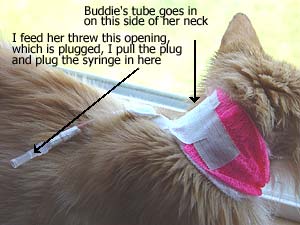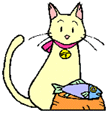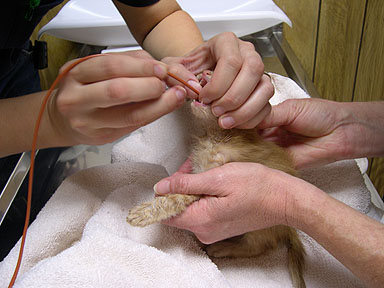Cat Force Feeding Simba Iams Cat Food
“Force Feeding” was the term originally used to mean anytime it was necessary to make a cat eat. Cat lovers don’t like this term because it just sounds kinda mean. So over time, we have started using the term “Assisted Feeding” or “Assist Feed” because we are helping our cats eat, not forcing them to eat (although kitty might disagree sometimes.) Force Feeding now mainly refers to truly force situations like tube feeding (see below).
“Assisted Feeding” now mainly refers to finger feeding or syringe feeding. Click this link to Read about Assisted Feeding…
Comment: I’ve read before that some veterinarians say that successful syringe feeding, finger feeding or spoon feeding is nearly impossible and that the best thing to do is implant a feeding tube. This is not always a true statement and is dependant on the cat illness.
For example, getting a kitty through a bad kitty cold is different that fighting feline hepatic lipidosis. And the amount of time your have to devote to feedings also plays into the decision. I am extremely fortunate in that I only work part-time away from my home so I have the luxury of syringe feeding on a 4-6 hour schedule. Other cat owners work full time or they have crazy work schedules, so I definitely respect the decisions that needs to be made to make sure the cat has the chance to survive.
I understand that huge advances have been made in surgical tube placement and it is not as invasive as it was several years ago. It is, however, still invasive and the procedure involves anesthesia which is always a huge risk with a sick cat.
Also, become educated about Appetite Stimulants just in case your veterinarian wants to prescribe them. Use with caution.
Here are the cat force feeding options:
Tube Feeding at the Veterinary Office – With this method of force feeding, a large sryinge is filled with either Hills a/d or Iams Max Cal. A thin, flexible feeding tube is attached to the tapered end of the syringe. The feeding tube is placed in the throat and then slid down the esophagus. The Hills cat food a/d and Iams cat food Max Cal are designed for this type of feeding and provide the maximum about of calories, even more calories that the liquid foods like CliniCare. As soon as the feeding is over, the tube is gently pulled out and the cat can rest confortably. Sometimes when a cat gets a full belly, it resets the hunger mechanism and the cat will start eating on it’s own again.
Click to see more of Simba’s Iams Cat Food Feeding Tube Pictures.
Nasogastric Tube is an option that sometimes works well for several days. This tube is passed through the nostrils and into the esophagus. It is taped and sutured in place. It has the advantage of easy placement and maintenance. The main problem is that the small diameter of the tube that is used only allows a liquid diet (CliniCare). To give an adequate amount of calories on a long term basis with this liquid diet would mean giving a volume of liquid that is far too much for the digestive system to handle, and the cat will usually vomit. (from Long Beach Animal Hospital http://www.lbah.com/Feline/ftube.htm#medium)
Esophagus Tube According to the Long Beach Animal Hospital web site “In terms of ease of placement, cost, and effectiveness, one of the best options for long term feeding is an esophagotomy tube. It does not require specialized equipment or exploratory surgery, and can usually be placed with sedation only.” The esophagotomy tube is surgically implanted in the side of the neck, goes down the esophagus but stops just before reaching the stomach. “Serious complications are rare, and usually consist of regurgitation of food if too much is given too rapidly, especially in the first few days of feeding.”
(http://www.lbah.com/Feline/ftube.htm#long Large paragraph after discussion about PEG Tubes.)
Buddie Sauro has shared her e-tube photo:

Click here to read more about Buddie
PEG Tube According to the Long Beach Animal Hospital web site “A very effective solution to long term feeding is a PEG tube. PEG stands for Percutaneous EndoGastric. It consists of a tube that passes from the inside of the stomach, through the abdominal body wall to the outside. It allows the long term use of food that will give adequate nutrition. Its first disadvantage is difficult placement. It is usually put in with a special instrument like an endoscope, or is placed surgically during an exploratory surgery of the abdomen. Requires general anesthesia. In addition, a further disadvantage is the potential for infection in the abdomen at the site the tube passes out of the stomach.” (http://www.lbah.com/Feline/ftube.htm#long)
For Tube Placement pictures and further discussion, please visit the Long Beach Animal Web Site located at: http://www.lbah.com/Feline/ftube.htm They do a great job at showing you the different tube options.
Disclaimer: Kathy Fatheree is not at all a medical expert. Contents of this web site are a collection of Kathy’s assist feeding experiences as well as the experiences of other cat owners who have assist fed their cats. While every effort has been made to ensure the accuracy of the information, Kathy Fatheree or anyone associated with this web site cannot be held responsible for anything that may happen as a result of using the information on this site.

